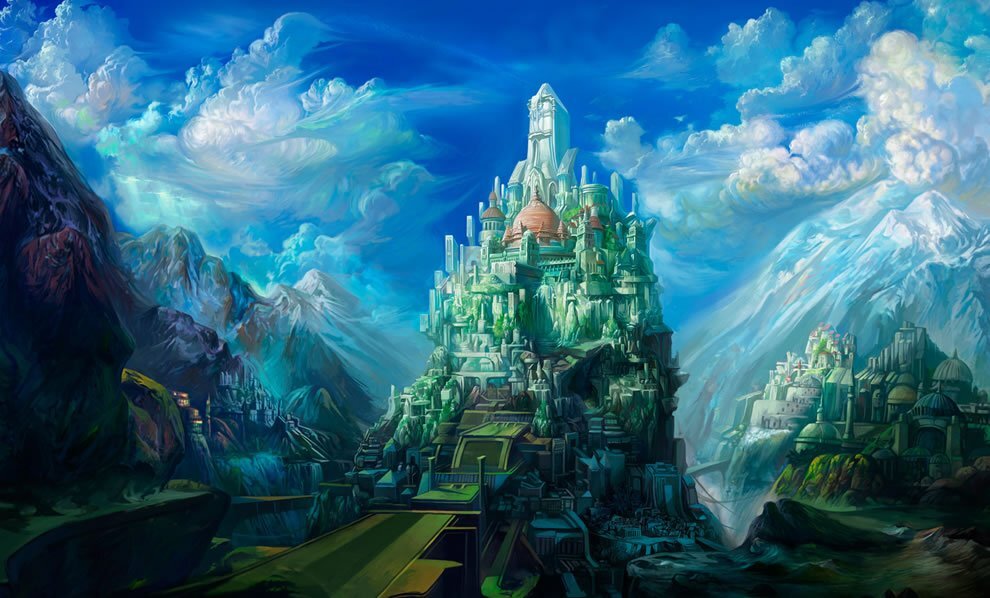The Basics of World Building: Organizing Your Ideas
If you’ve been on a community forum or facebook group focused on D&D, there’s a good chance you’ve seen questions regarding how to build a homebrew world. It’s an overwhelming task to some, not often because they’re completely lost on ideas, but because they have no idea how to narrow down the process of taking those ideas and making them a reality. If you want to make your own world, chances are you already have the creative chops, but as much as we’d like to think that’s all you need, there is always a process to making sure your ideas come across clearly and effectively to players. Barren worlds are not fun to play in, but neither are worlds so cluttered and difficult to understand that you can’t latch onto them. This guide - the first of a series of articles regarding the basics of world building - will help you slow your brain down and do less daydreaming and more actual writing.
Start Where Inspiration is the Strongest
Gosh, I just don’t even know where to start!
For me, my favored method is to build outward and not inward. Start small, then slowly fill out the details, drawing further and further from the center until you suddenly have an entire world to work with. This way of thinking allows you to compartmentalize your thoughts so you don’t get easily distracted by other aspects. It also makes it so you can get rough ideas out right away. Remember: you can always go back and change aspects later, and editing things down is an important step in the creative process. But, it’s easier to edit something that has a foundation.
You don’t have to start the creation process in any particular order. If you’re making a whole universe, you don’t have to start with who/what made it. When it comes to complex lore and history, I prefer to do that after already having some concrete ideas for how the world is currently. You can always answer the why later. For now, pick a location and work from there, then backwards. I didn’t make an actual creation myth for my world until after all the locations were set up. I already had Point B, and I worked backwards to Point A.
For example: I have a mystical tree in the capital Elven city in my homebrew world. I had zero explanation for why it was there initially, then, after the city was set up, I decided to give it a reason for being there. At the beginning, it was just a cool tree, because I didn’t want to stunt my process by getting stuck on that one aspect of the area, wracking my brain to think of something. I put a pin in it and moved on, which is something you’ll find yourself doing a lot when you’re taking on such a big project.
You’ll find some things you immediately have explanations for, and other things you only have vague notions for, and that’s totally fine! Remember: you don’t have to have everything figured out right from the start, and some things will be sloppy or contradict one another. It’s okay for things to be messy, and then to go back and edit them down. Starting small and working outward helps you not get overwhelmed with too many things at once, so if you do experience a bit of brain fog, it’s not the entire universe, but just that one tree in the city.
Great! Now, Slow Down
Building off the last point, if you’re like me, you love a good aesthetic. Ideas for worlds often come in the form of landscapes and loose ideas in our heads; a castle floating in the sky, an underground river lit by bioluminescent algae, a dark fortress surrounded by deadly woods, a lifeless starship lost in space. But, thinking solely of aesthetics launches you down a slippery slope, and you start to get overwhelmed creatively and lose track of what you were thinking about in the first place.
One of the most important things to keep in mind when creating a world is making it accessible. Put clarity and ease of understanding above everything else, and that means prioritizing the simplest aspects of your world. It’s much easier to make separate building blocks and slowly put them together than to try and break down a massive blob of information.
Don’t make a world where every detail has to be fully consumed in order to understand it. For example: the Star Wars universe does not have to be completely understood to be enjoyed. Learning the little details of different planets, political motives, and characters is nice, but doesn’t have to be learned to enjoy what’s in front of you. You should instead have the basics build intrigue, not a mountain of information that needs to be surpassed.
Do, however, write those details! Get as in-depth as you want, and make it a point of discovery for your players to find those things out. You should leave some things up to others to learn, even if you know all the information.
Write a Lore Archive
Every DM has different methods for storing information on their world. Some use good old fashioned notebooks, others have binders, others have everything online. Personally, I store every chunk of lore in a folder on Google Drive, called the Guide to Aldorah. You can also use sites that are dedicated to making your lore look like Wiki pages, like World Anvil. Whatever method you use, the most important thing is to make sure you have a safe place to record your ideas and have an archive for everything you’ve made.
Google Docs are my personal favorite, since they save automatically and can be recovered if something happens to your computer. They’re also super easy to share with others by granting editing access, so if you need a second opinion, they can do so with ease. When the lore is ready and you’re satisfied with it, you can then share it with the people in your campaign when relevant!
I have separate documents for each continent in my world, as well as different aspects of it like magic, gods and goddesses, resurrection rituals, holidays, guilds, and creation theory. Make the titles clear and easy to find if you need quick reference.
Understand that Players will Blindside You
This is a point that is extremely relevant both for gameplay and for world building, the earlier of which will not be addressed here. When you make your world, it’s fun to come up with explanations for locations, people, events, etc. You’ll likely have a lot of it worked out by the time you start your game, but just know that there’s a very good chance your players will ask you a question or present you with a scenario or cause and event that you were not prepared and don’t have immediate answers for. This is when your skills as a DM and your skills as a writer will blend.
Anyone who’s been a DM for a while will tell you that one of the most important skills to have is improv, and that goes for out of character curiosity as much as it goes for in character actions. So, make your world flexible. Give yourself wiggle room to be able to add things on the fly when needed, and be able to do so without worrying about completely destroying the foundation. Don’t worry about answering every possible question before you even begin your game, because that is not going to be possible, and you’re going to end up stressing yourself out.
It’s also worth noting that you are going to need all the information on the lore, but not the players. You don’t have to spend several hours painstakingly creating the agricultural yields of a farming village if the players are never going to ask or have to handle that information. If they do inexplicably want to know about that, you can add it later, but it’s okay to leave things up to interpretation and answer as needed instead of trying to predict everything.
Finally: Do Not Worry if Something’s Been Done Before
I noticed a lot of creators get super hung up on trying to make their world 100% without a doubt original in every possible aspect. If you can manage that, I applaud you, but I can tell you now that if you make that your goal, you’re going to burn yourself out. Instead of trying to reinvent the wheel for every part of your world, be totally fine with taking something that exists and putting your own spin on it. Of course, I don’t recommend just copying and pasting, but you can absolutely take a common trope and make it your own. Make those Elves tall and beautiful, give those Dwarves Scottish accents, make the sky have two moons, etc: you can find ways to make those things your own.
Taking inspiration from other creative outlets is how most of us got into writing and creating in the first place. Invoking the work of others without completely ripping them off is not just possible, but encouraged. Chances are something you’ve made is going to remind someone of something else, and that’s okay.
You’ll come up with plenty of ideas on your own. Trust in yourself and you shed the anxiety quickly. Don’t sweat the small stuff and you’ll find yourself generating concrete ideas to work from quickly!






